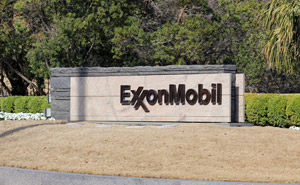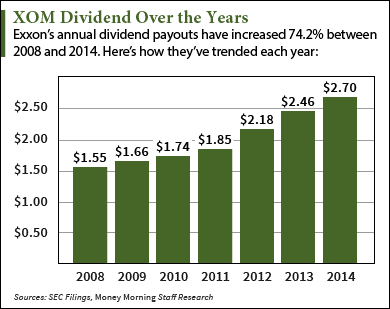 Exxon Mobil Corp. (NYSE: XOM) dominates the world of Big Oil in terms of market cap and brand recognition. The $364 billion company is widely embraced by income investors thanks mostly to the healthy XOM dividend.
Exxon Mobil Corp. (NYSE: XOM) dominates the world of Big Oil in terms of market cap and brand recognition. The $364 billion company is widely embraced by income investors thanks mostly to the healthy XOM dividend.
Oil stocks provide some of the best dividends on the market. The oil drilling and exploration sector has an average dividend yield of 17.84% thanks to most firms being structured as master limited partnerships (MLPs), trusts, or limited liability corporations (LLCs). That yield smashes the S&P 500’s 1.93% average and the Dow Jones’ 2.65% average. The XOM dividend yield is 3.17%.
But with oil prices still far below record highs, does the XOM dividend make Exxon stock a buy today? Here’s a look at XOM’s value to your portfolio…
Exxon (NYSE: XOM) Dividend Boasts Aristocracy
First, now is still a great time to buy dividend stocks with healthy yields like Exxon’s.
The 10-year Treasury yield has fallen 10.1% so far this year. It lingers around 1.92% as of April 24. That means investors are currently seeking stable dividend-paying stocks for passive income.
According to Forbes, a dividend stock is a good bond replacement because it can be viewed as “a floating-rate bond with an ‘equity kicker’ in that the share price could rise.” In other words, dividend stocks have all the benefits of a bond – but with potentially better returns due to increasing share prices.
One way to tell if a company can support its dividend is to look at its S&P AAA credit rating. Companies with AAA ratings are trustworthy in terms of their credit history and indicate high investment quality.
The 2008 recession saw many companies, such as General Electric Co. (NYSE: GE), lose their AAA rating. The list of AAA U.S. companies now only includes Johnson & Johnson (NYSE: JNJ), Microsoft Corp. (Nasdaq: MSFT), and Exxon. 
With a AAA rating and the highest yield of all three, the XOM dividend is one of the best on the market.
XOM has delivered a constant stream of quarterly payouts since starting its dividend policy 32 years ago. The XOM dividend’s 6.4% average annual growth rate has made it one of the most mature high-yield oil plays since the policy’s inception.
Exxon is one of the few energy companies that is a “dividend aristocrat.” The dividend aristocrats are stocks on the S&P 500 that have increased their payouts for at least 25 consecutive years. The list has grown from 42 constituents in 2010 to 54 in 2014.
And its growth smashes that of other oil companies by a huge margin. Exxon’s dividend has increased 34.2% more than BP Plc.’s (NYSE ADR: BP) dividend in the last three years. Exxon’s payout growth has also beaten that of Royal Dutch Shell Plc. (NYSE ADR: RDS.A) by 60.4% in the last five years.
Now for the big question…
With a Healthy Dividend, Is Exxon Stock a Buy?
As the largest U.S. oil company, XOM stock is in the best position to soar as oil prices rebound and M&A revives the industry.
Small oil stocks are about to be bought out by much larger ones like Exxon. The process will create a new group of heavyweight firms that will bring the market into the “new energy age.”
"The most likely targets of M&A activity will be energy companies with attractive land leases, pipelines, or other assets, high levels of debt, and declining cash flows," Money Morning Global Energy Strategist Dr. Kent Moors said. "These types of companies could hand their shareholders a quick profit in 2015 if they get targeted."
Exxon typically does some strategic buying during low price periods. It snatched Mobil Corp. for $82 billion in 1999 when oil hovered near $20 a barrel. Exxon bought XTO Energy Inc. – one of the largest gas producers in the United States – for $25 billion in 2010 when prices had fallen 70% in a year.
Now, with prices down more than 40% since June 2014, Exxon is poised to strike again.
According to a report by Wolfe Research analyst Paul Sankey, BP “is the obvious fit” for Exxon’s next acquisition target. Exxon’s head of investor relations Jeff Woodbury has stated that the company is “very alert to value propositions” and will “pursue only those acquisitions that we think have ultimate strategic value and are accretive to our longer-term returns.”
Make More Money This Year, Starting Today… You can make 2015 your wealthiest year in a few simple moves. You just need the three common investing habits to dump immediately, the single most effective strategy for your portfolio, and five stocks to get you started to a wealthier you. Get all of that right now in this exclusive guide…
Thoughts on the XOM dividend? Let’s talk about it: @AlexMcGuire92
Related Articles:


